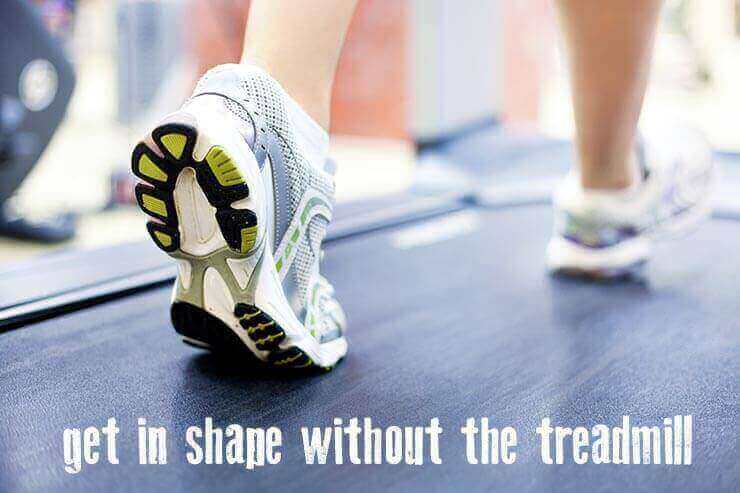Fitness is a touchy subject for a lot of people these days. Everyone has an opinion and a favorite type of exercise to help get in shape (from none at all to excessive and everything in between). What is truly the best type of exercise? Is it different for men and women? What about moms like me who don’t have the time to log the suggested 60 minutes a day?
These are the questions I set out to answer. For me, fitness was a passion I had to develop and I wanted my kids to enjoy physical movement and stay in shape without ever having to go “work out”. (I never liked that term! If we associate it with work, who wants to do it?) With the help of my athletic husband and brother-in-laws, I set out to find the answers.
Before we can figure out the best type of fitness, we must figure out the goal of a fitness regime in the first place. I wonder, for all the gym bots who log endless miles on the treadmill: is the goal to be able to run endless miles on the treadmill? I understand that for many, marathons and other races provide motivation and this is the goal, but is the best type of exercise, especially for women?
I thought about my true goals in fitness: to have a healthy physique, to be able to join a pick up game of flag football if the opportunity arose, to be able to kayak with my husband, to be able to keep up with the kids, to have enough strength of movement to be able to rock climb, swim, scuba dive, or hike whenever I had the chance. More importantly, for me, was the ability to react quickly and competently if a life-threatening situation ever arose, especially when I was with my kids.
From conversations with other moms, this last goal seems to be an important one, in thought at least. I know of a mom who had to crawl out a second story window and onto her roof while holding her newborn to escape a flood. I know a mom who climbed a tree while holding a toddler to avoid an angry dog. I know a mom who jumped into a lake at a local park and swam to shore towing a 200 pound man who was having difficulty. Could I do these things, I wondered?
I read a story of a man who was sitting on the beach when the water line receded quickly and he saw a dark line on the horizon. Realizing it was a tsunami, he sprinted away from the beach. The only means of escape that the water would not reach was atop a rocky face about 40 feet up. He sprinted to the rocks and climbed up with just seconds to spare. He had the fitness to keep himself alive, but he watched with horror as many others did not. People died that day because they did not have the physical ability to save their own lives.
Would I be able to survive in that situation? More importantly, would I be able to survive and get my kids up also? While these situations are rare, other situations where proper fitness determine our ability to save our own lives are much more commonplace. How many studies have you read about the links between high fitness levels and decreased risk of cancer, heart disease and stroke? Pretty much all of the experts agree that fitness is important, which brings us back to the big question-how do we get there?
In all of the above situations, I don’t think the hour a day of mindless running on a treadmill like a caged hamster will have a tremendous effect on survival ability. I realized that what we truly need is functional fitness- a level of fitness that makes daily activities (and extreme ones) easier. God-willing, none of us will ever have to escape a tsunami or save a drowning person, but if we did… shouldn’t we be prepared?
The mindset of conventional society seems to be that we need 30-60 minutes of moderate level aerobic activity every day for optimal health. I realized that as a Mom, it would be difficult to do this, and even if I could, would it really be the best option? Is more always better? You tell me:

Who looks healthier? But these are men, you say, what about women?

Which would you rather look like?
What about the heart benefits, the CARDIO… what about the cardio!? This is one of the most common responses I get when I start suggesting a different type of exercise. There are several important factors that come into play here. Cardio/aerobic activity is the most common type of athletic activity, especially among women. Some even venture into the realm of long-distance running or other endurance sports. While these can have benefits, we must look at them in the context of the life-long effect on one’s body.
To grossly simplify a rather complex subject- your body has two types of fibers, slow twitch and fast twitch. Slow twitch is responsible for distance and endurance at slower paces and fast twitch is responsible for the ability to achieve short bursts of very high levels of activity. The fast twitch fibers are actually broken into two types- fast and super fast. Regular fast twitch fibers move approximately 5 times as fast as slow twitch and super fast twitch move approximately 10 times as fast as slow twitch. As an example- most marathoners have about 80% slow twitch, while most sprinters have about 80% fast twitch. (Back to the above, which looks healthier?)
According to research, most people have relatively equal levels of the two types, and this is at least partially determined by genetics. Which type of twitch fiber you work to develop would of course depend on your fitness goals, but in general, which one is better to focus on?
Ever heard of Human Grown Hormone? Kids are full of it and it contributes to their rapid growth and faster ability to heal. As we age, our levels of growth hormone decrease, and we age. Some people go so far as to spend astronomical amounts of money to receive injections of growth hormone. Where am I going with this? High Intensity Exercise (short, fast bursts) as been shown to release exercise induced growth hormone into the body. As growth hormone is perhaps the best fat-burning, anti-aging, strength building, substance we know of, it might be a good idea to get some of that kind of exercise.
The average person who does cardio activity at the recommended rates has about 40% slow twitch fibers, 50% fast twitch and 10% super fast twitch (not much growth hormone there!) A person who trains in high-intensity exercises has 40% slow-twitch, 20% fast twitch and 40% super fast twitch. That is 4 times the amount of growth hormone produced from exercise!
It gets better though- research shows that exercise that uses fast-twitch and super-fast twitch fibers also develops the slow-twitch fibers as well as exercise that just focuses on slow-twitch (like the treadmill). Unfortunately, the reverse is not true, endurance exercise develops the slow-twitch fibers but does not work the fast or super fast twitch fibers at all (no growth hormone here!). Even worse, these fast twitch fibers will eventually atrophy if they aren’t used.
If we look at kids (a great example of natural athletic ability and great form) what do we see? Ever see a kid under 5 logging a quick 4 miles before school? Kids are the experts in sprinting, climbing and short bursts of activity that develop the growth hormone they need and produce so well. Kids do not naturally gravitate to long distance exercise or extended patterns of the same movement over and over. How many of us could squat down for 5 minutes straight while playing legos? Could we climb a tree? Dominate at a game of capture the flag? What if we could maintain this level of athletic ability? Perhaps that growth hormone could help, eh?
So while kids get to play outside, sprint barefoot and climb trees, we sullenly trudge off to the gym each day to log our miles and pat ourselves on the back for our commitment to health. I marvel at those who can run the hamster wheel for two hours, but I have to ask myself, if they could accomplish the same thing in 30 minutes of high-intensity exercise and use the extra 90 minutes for something else they enjoy, would they do it?
I always hear people say how they don’t really enjoy exercise, but love the feeling afterward, so they do it. What if we could do it in less time, with the same results? I would hope we would all do it!
I can hear the objections already though… What if I have bad joints? I have never been a sprinter! The list goes on. Luckily, fast twitch and super fast twitch are developed by short bursts of high intensity of any type of exercise that can achieve this. For some, this may be running sprints, for others, a spin bike, for others, a kettlebell… as long as it is fast and short, it will work. Personally, I just head outside and sprint it out, but I know a lot of people who, due to previous injuries or bad knees, get their sprints in on a bike and have great results. What was surprising to me: I was able to run a sprint triathlon (technically an endurance type event) after training almost entirely with high-intensity activity in short bursts. I barely endurance trained at all, and was able to run, swim, and bike faster than I ever had. I did weight training (mainly kettlebells) to develop strength, and can actually do a pull up now, a feat I previously thought impossible!
There are a few other factors, of course, that contribute to the success of this type of exercise. Emerging research shows that consuming fructose (even from fruit) within 2 hours of a high-intensity exercise releases the chemical somatostatin in the body, effectively stopping growth hormone production. Eating an extremely high-fat meal right before a workout (within an hour) can also inhibit growth hormone production.
Removing grains from your diet, and consuming the right kinds of fats and proteins will also allow your body to increase fast twitch fiber, improve athletic performance and burn body fat more quickly. Getting enough sleep, drinking enough water and getting enough Vitamin D are also crucial.
If your goals are similar to mine at all (improved physique, speed, strength and ability to do fun activities if the opportunity arises) this is what I do:
Twice a week: Sprint Sets. I use a modified Tabata routine interspersed with a longer rest routine. I usually run one set of Tabata sprints (sprint 20 seconds, rest 10, repeat for 4 minutes) followed by a long rest period and a 30 second sprint followed by a 60 second rest (repeat 8 times). Followed by another set of Tabatas. In case that was confusing, here is a broken down version:
- Sprint 20 seconds
- Rest 10 seconds
- Repeat above two steps 8 times
then
- Sprint 30 seconds
- Rest 60 seconds
- Repeat above two steps 8 times
then
- Sprint 20 seconds
- Rest 10 seconds
- Repeat above two steps 8 times
These could be done running, on a stationary bike, with kettlebells or any other activity that can be done quickly. I don’t recommend swimming for sprints because it doesn’t have the benefits of weight bearing exercise.
Two or Three Times a Week– Strength Training. I am a big proponent of exercise that utilizes body weight as it can be done anywhere, it can be done relative to your fitness level, and it is less likely to cause injury than free weights (especially if weights are done with bad form!). Body weight exercises can also be done quickly and without any added equipment, making them perfect for a workout while the kids are napping. I do a total of about 20 minutes each time I do strength, though work up to more, or start with less as needed. I focus primarily on the following exercises:
- Pull ups -These can be done on a tree branch or a portable pull up bar in a door frame. Start with assisted pull ups if needed.
- Push ups -Start with wall push ups or “girl” push ups if you need to work your way up. Work up to doing them with your feet elevated or in a handstand.
- Squats– Start small if you need to and work up to a full squat.
- Planks– One of the best all-over exercises you can do. Rest on elbows, forearms and toes. Hold as long as possible. Repeat several times. Once you can do this, mix it up by raising one arm or leg and holding the position or by holding in a low-push up position instead of resting on forearms.
I am not a doctor or a personal trainer, so, as the exercise machines suggest, you should consult with a doctor (and a good trainer) before beginning any exercise routine. If you get dizzy, stop… etc.
What’s your favorite way to “work out”?




Leave a Reply